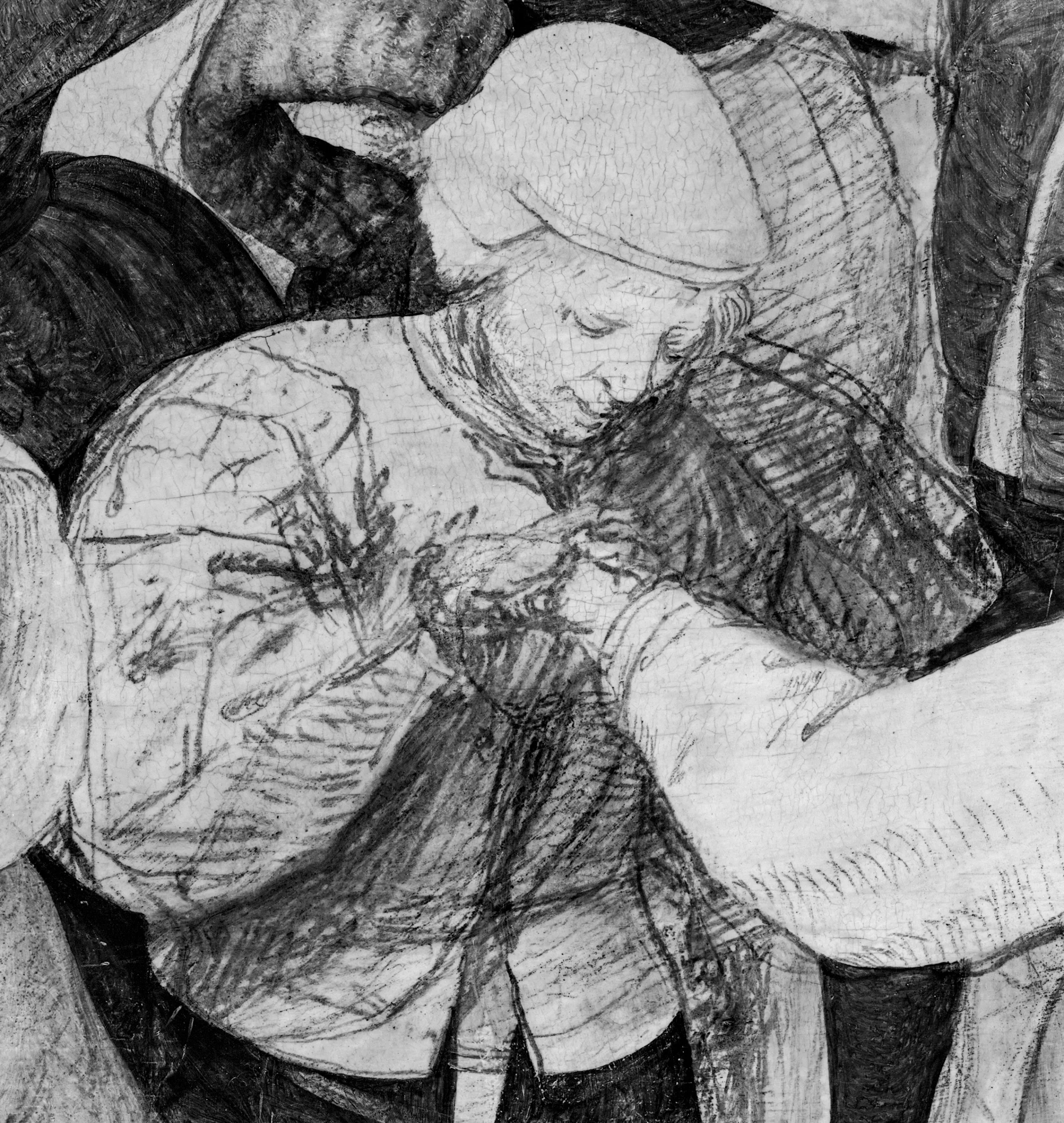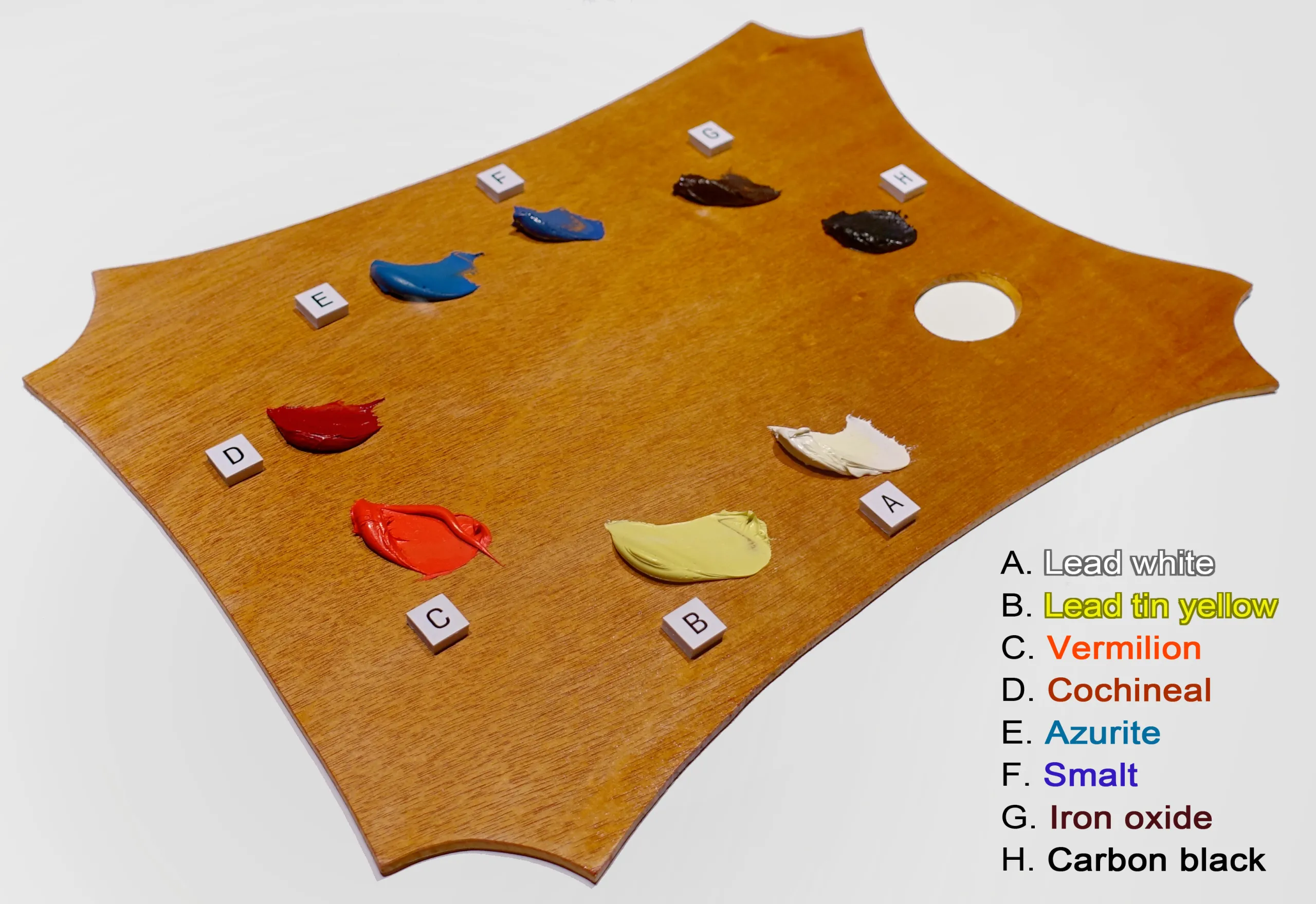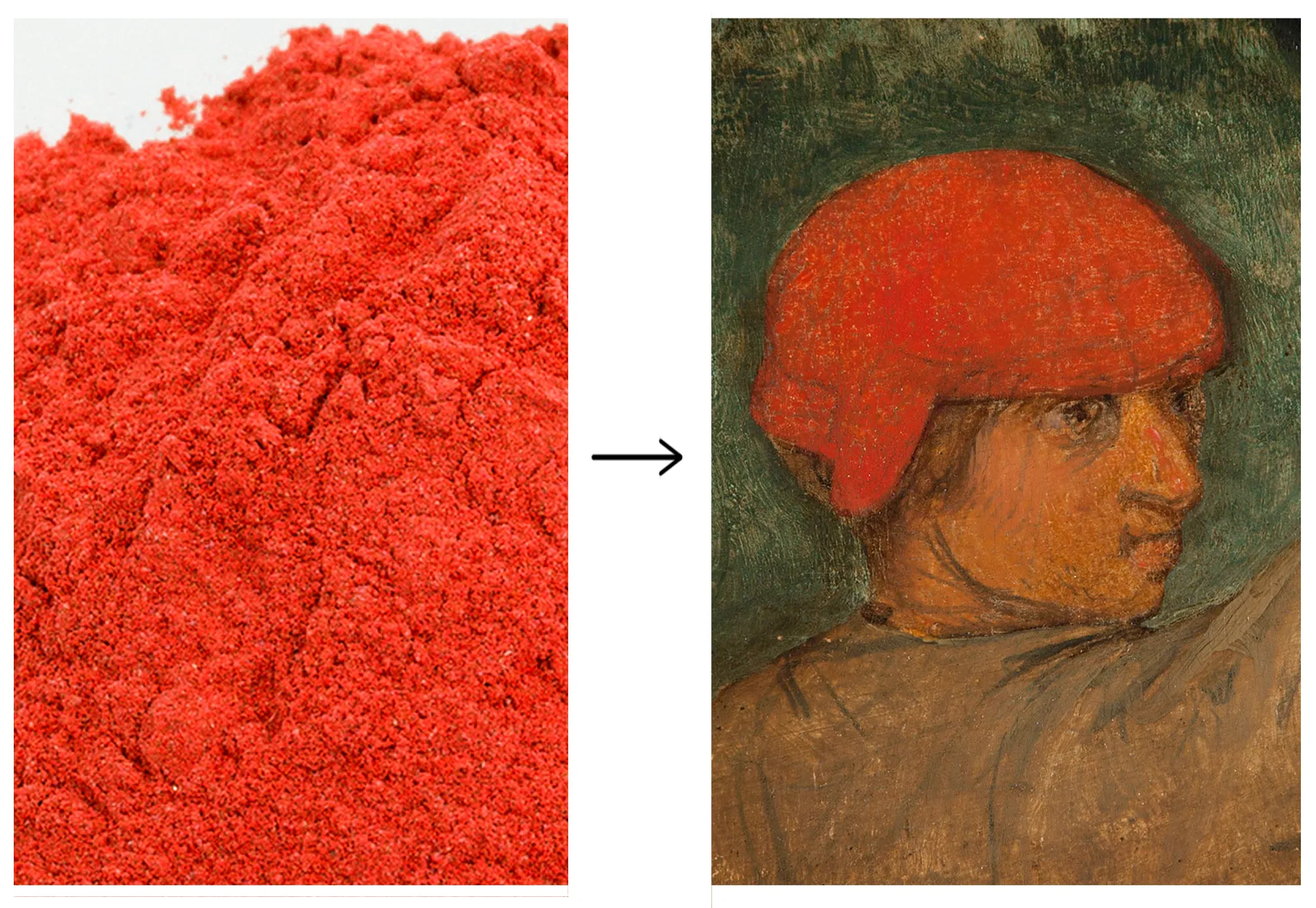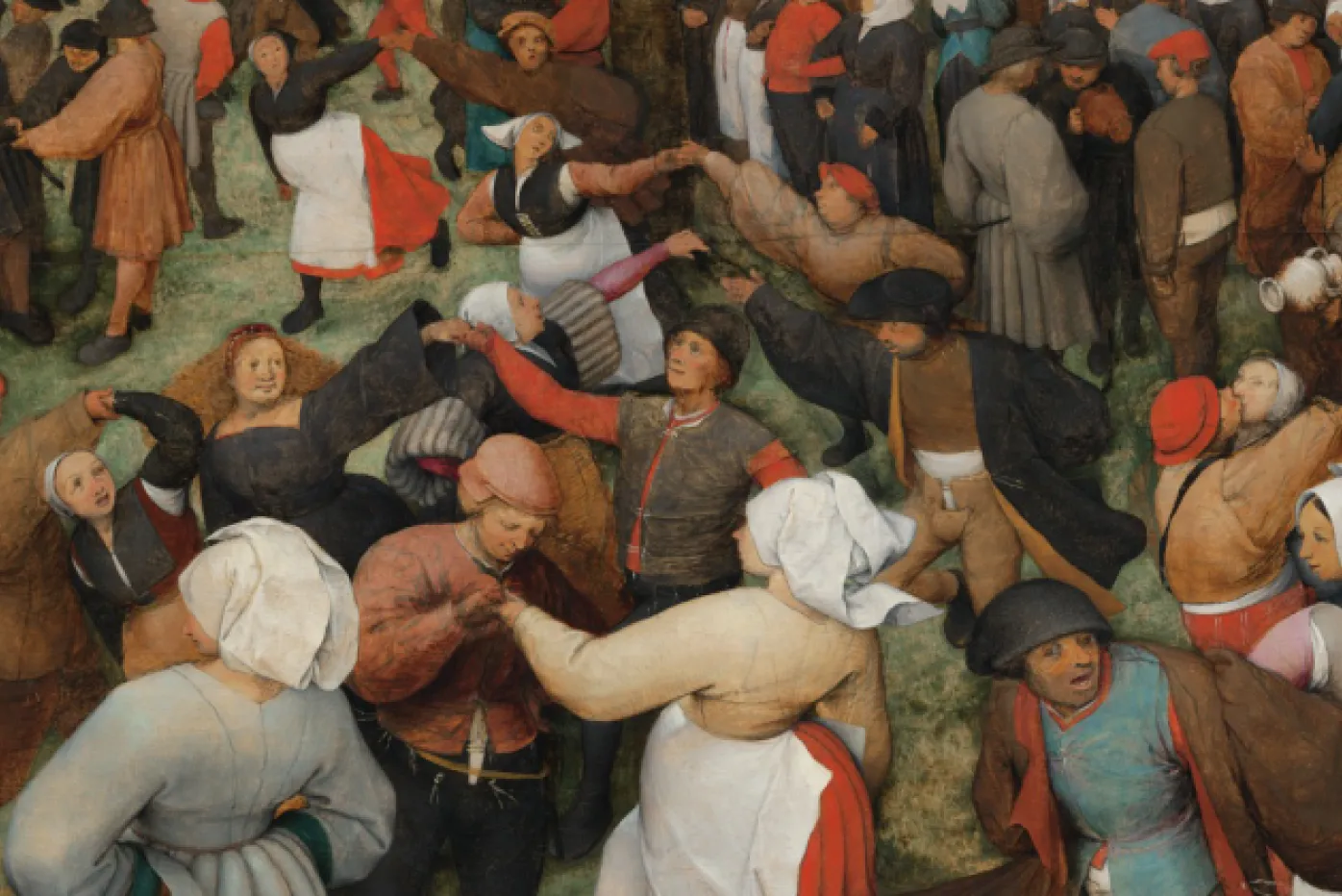
Underdrawing in Bruegel's "The Wedding Dance"

Pigments in Bruegel's "The Wedding Dance"

Vermilion in Bruegel's "The Wedding Dance"
Updated Jul 20, 2022
The DIA’s exhibition Bruegel's ‘The Wedding Dance’ Revealed is a collaboration between the DIA’s Conservation Department and European Art departments that traces the life of the painting from its creation in 1566 to the present, including the story behind the DIA’s exciting acquisition of the work in 1930. The exhibition also commemorates the 450th anniversary of the artist’s death.
While visitors cannot see the exhibition in person, they can still get a behind the scenes look at “The Wedding Dance’ Revealed” while at home! The museum’s Bruegel team brings slices of the exhibition online. This first installment shares insights about the painting’s panels, underdrawing and paint colors. The bolded phrases below correspond to their matching images in the gallery.
The bugs are long gone, but on the back of the wooden panel on which The Wedding Dance was painted is an open insect tunnel. Although this tunnel is quite small, it is surprising to find, since insects do not usually attack oak. Oak can become more appetizing for an insect if the wood experiences high humidity or a water event and enters the early stages of decomposition. This insect tunnel provided conservators with their first visual clue that the panel had deteriorated with age, a suspicion that was later confirmed by microscopic wood analysis.
Bruegel painted The Wedding Dance on an oak panel made from four individual boards, held together with glue and dowels. The dowels are now hidden from view but visible in an X-radiograph of the painting. However, there are none of the characteristic dowels along the uppermost join, connecting a fifth narrow board. And, wood analysis revealed that this narrow board along the top came from a different tree. This, combined with other evidence, helped conservators determine that the top (fifth) section was a later addition. Bruegel likely never meant for The Wedding Dance to have a horizon.
Best seen with infrared reflectography, the underdrawing beneath The Wedding Dance is extraordinarily detailed. The revised contours and hatched lines are not typical of Bruegel’s underdrawings, even those that are considered comprehensive examples. Bruegel used this underdrawing as a working sketch, a flexible draft that he created to help him develop his ideas. This underdrawing serves as an important glimpse into Bruegel’s working process, particularly because none of his compositional drawings for paintings have survived.
Bruegel’s underdrawing beneath The Wedding Dance was made using black chalk, not charcoal as is commonly believed. Although the term “black chalk” has been accepted since the 14th century, it is not an accurate description of the material. Chalk, by definition, is white and made of limestone. The medium known as black chalk in use from the 14th-18th centuries was a naturally occurring slate metamorphosed from shale, and it could easily be cleaved into drawing sticks. Black chalk from this time period differs from modern synthetic black chalk, which has been widely available since the 18th century and is made by mixing ground-up natural or synthetic pigment with a filler and a grease, wax, or oil. This image is a modern recreation of Bruegel’s underdrawing using traditional black chalk.
Bruegel’s used several pigments to create the colors in his paintings. Using a variety of scientific analytical techniques, we identified the following pigments in The Wedding Dance: vermilion and cochineal (reds), lead tin yellow, azurite and smalt (blues), carbon black, lead white, and iron oxide Earths (browns, reds, yellows).
Vermilion (red) was a popular color for European painters in the 1500s, including Pieter Bruegel. The pigment can be obtained naturally from the mineral cinnabar. It can also be made synthetically using mercury and sulfur in a process called sublimation (when a solid is heated into a vapor and condensed onto a cool surface into a new solid). This is a hazardous and messy process, so during Bruegel’s time, artists would purchase the pre-made synthetic pigment from specialist merchants known as ‘verfvercopere’ in Dutch or ‘marchand de couleurs’ in French. Vermilion is present in a variety of locations within The Wedding Dance such as the red vest of the bag piper in the bottom right corner.
Bruegel also used cochineal, a red that came from bugs for use in art, carminic acid was extracted from small scale insects called American, Polish, or Armenian Cochineal and then “laked” onto blank pigment particles for use in art. Cochineal shipments arrived in Antwerp as early as 1523, and in Bruegel’s time, American cochineal was one of the most imported dyes. In fact, when Spain began its Central American colonization in the early 1500s, this dye became one of its most profitable exports, second only to precious metals like gold and silver. Laked cochineal appears in various pink areas of the painting, such as this man’s hat and the bride’s headband.
One of Bruegel’s yellow pigments is lead tin yellow, which had been used in European paintings from the late 13th to the mid-18th century, when it fell out of favor. The pigment was forgotten and only rediscovered in 1941. This means that when lead tin yellow is detected in an undated painting, there is a good chance the work was made before 1750. The presence of lead tin yellow in the top strip added later to The Wedding Dance dates the format change within the first two hundred years after Bruegel completed the painting. And Bruegel himself typically used the pigment only in mixtures with blue azurite to make green.

"The Wedding Dance," 1566, Pieter Bruegel the Elder, Netherlandish; oil on wood panel. Detroit Institute of Arts.
The DIA’s exhibition Bruegel's ‘The Wedding Dance’ Revealed is a collaboration between the DIA’s Conservation Department and European Art departments that traces the life of the painting from its creation in 1566 to the present, including the story behind the DIA’s exciting acquisition of the work in 1930. The exhibition also commemorates the 450th anniversary of the artist’s death.
While visitors cannot see the exhibition in person, they can still get a behind the scenes look at “The Wedding Dance’ Revealed” while at home! The museum’s Bruegel team brings slices of the exhibition online. This first installment shares insights about the painting’s panels, underdrawing and paint colors. The bolded phrases below correspond to their matching images in the gallery.
The bugs are long gone, but on the back of the wooden panel on which The Wedding Dance was painted is an open insect tunnel. Although this tunnel is quite small, it is surprising to find, since insects do not usually attack oak. Oak can become more appetizing for an insect if the wood experiences high humidity or a water event and enters the early stages of decomposition. This insect tunnel provided conservators with their first visual clue that the panel had deteriorated with age, a suspicion that was later confirmed by microscopic wood analysis.
Bruegel painted The Wedding Dance on an oak panel made from four individual boards, held together with glue and dowels. The dowels are now hidden from view but visible in an X-radiograph of the painting. However, there are none of the characteristic dowels along the uppermost join, connecting a fifth narrow board. And, wood analysis revealed that this narrow board along the top came from a different tree. This, combined with other evidence, helped conservators determine that the top (fifth) section was a later addition. Bruegel likely never meant for The Wedding Dance to have a horizon.
Best seen with infrared reflectography, the underdrawing beneath The Wedding Dance is extraordinarily detailed. The revised contours and hatched lines are not typical of Bruegel’s underdrawings, even those that are considered comprehensive examples. Bruegel used this underdrawing as a working sketch, a flexible draft that he created to help him develop his ideas. This underdrawing serves as an important glimpse into Bruegel’s working process, particularly because none of his compositional drawings for paintings have survived.
Bruegel’s underdrawing beneath The Wedding Dance was made using black chalk, not charcoal as is commonly believed. Although the term “black chalk” has been accepted since the 14th century, it is not an accurate description of the material. Chalk, by definition, is white and made of limestone. The medium known as black chalk in use from the 14th-18th centuries was a naturally occurring slate metamorphosed from shale, and it could easily be cleaved into drawing sticks. Black chalk from this time period differs from modern synthetic black chalk, which has been widely available since the 18th century and is made by mixing ground-up natural or synthetic pigment with a filler and a grease, wax, or oil. This image is a modern recreation of Bruegel’s underdrawing using traditional black chalk.
Bruegel’s used several pigments to create the colors in his paintings. Using a variety of scientific analytical techniques, we identified the following pigments in The Wedding Dance: vermilion and cochineal (reds), lead tin yellow, azurite and smalt (blues), carbon black, lead white, and iron oxide Earths (browns, reds, yellows).
Vermilion (red) was a popular color for European painters in the 1500s, including Pieter Bruegel. The pigment can be obtained naturally from the mineral cinnabar. It can also be made synthetically using mercury and sulfur in a process called sublimation (when a solid is heated into a vapor and condensed onto a cool surface into a new solid). This is a hazardous and messy process, so during Bruegel’s time, artists would purchase the pre-made synthetic pigment from specialist merchants known as ‘verfvercopere’ in Dutch or ‘marchand de couleurs’ in French. Vermilion is present in a variety of locations within The Wedding Dance such as the red vest of the bag piper in the bottom right corner.
Bruegel also used cochineal, a red that came from bugs for use in art, carminic acid was extracted from small scale insects called American, Polish, or Armenian Cochineal and then “laked” onto blank pigment particles for use in art. Cochineal shipments arrived in Antwerp as early as 1523, and in Bruegel’s time, American cochineal was one of the most imported dyes. In fact, when Spain began its Central American colonization in the early 1500s, this dye became one of its most profitable exports, second only to precious metals like gold and silver. Laked cochineal appears in various pink areas of the painting, such as this man’s hat and the bride’s headband.
One of Bruegel’s yellow pigments is lead tin yellow, which had been used in European paintings from the late 13th to the mid-18th century, when it fell out of favor. The pigment was forgotten and only rediscovered in 1941. This means that when lead tin yellow is detected in an undated painting, there is a good chance the work was made before 1750. The presence of lead tin yellow in the top strip added later to The Wedding Dance dates the format change within the first two hundred years after Bruegel completed the painting. And Bruegel himself typically used the pigment only in mixtures with blue azurite to make green.

Underdrawing in Bruegel's "The Wedding Dance"

Pigments in Bruegel's "The Wedding Dance"

Vermilion in Bruegel's "The Wedding Dance"